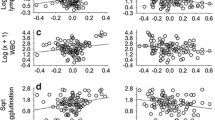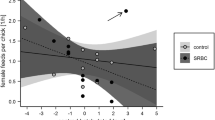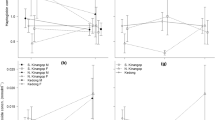Abstract
It is assumed that there is a trade-off between the costs allocated to mounting an immune defence and those allocated to costly functions such as breeding and moulting. The physiological basis for this is that mounting an immune response to pathogen challenge has energetic and/or nutrient costs which may interfere with metabolic processes of the challenged individual. If the energetic costs of mounting an immune response are not too high, animals may face such costs by increasing their acquisition of food energy, suggesting that limited nutrients may be responsible for the costs of immune defence. We assessed the energetic and developmental costs of mounting an immune response in an experiment in captivity with first-year greenfinches (Carduelis chloris) challenged with sheep red blood cells and Brucella abortus. Antibody production against both antigens increased the daily energy expenditure (4.7%) of immune-challenged birds relative to control birds, although the difference was non-significant. We estimated that the maximum effect size supported by the data would be 9.9% higher in immune-challenged birds relative to control birds. We plucked the two outermost rectrices of each bird to assess the effects of the immune challenge on growth of the regenerated feathers. The immune challenge had no significant effect on the length of the regenerated rectrices. However, these feathers were more asymmetric in length in immune-challenged birds than in control birds. Although first-year male greenfinches paid a relatively low energetic cost when mounting an immune response, we suggest that immune-challenged individuals may have paid some costs over the long term based on the increased fluctuating asymmetry in the developing feathers.



Similar content being viewed by others
References
Apanius V (1998) Stress and immune defense. Adv Study Behav 27:133–153
Birkhead TR, Fletcher F, Pellat EJ (1998) Sexual selection in the zebra finch, Taenopygia guttata: condition, sex traits and immune capacity. Behav Ecol Sociobiol 44:179–191
Bonneaud C, Mazuc J, Gonzalez G, Haussy C, Chastel O, Faivre B, Sorci G (2003) Assessing the cost of mounting an immune response. Am Nat 161:367–379
Buttgereit F, Burmester G-R Brand MD (2000) Bioenergetics of immune functions: fundamental and therapeutic aspects. Immunol Today 21:192–199
Campo JL, Gil MG, Dávila SG, Muñoz I (2005) Estimation of heritability for fluctuating asymmetry in chickens by restricted maximum likelihood. Effects of age and sex. Poultry Sci 84:1689–1697
Civantos E, Forsman A, Ahnesjö J (2005) Developmental instability and immune function in colour polymorphic pygmy grasshoppers. Evol Ecol 19:1–14
Colegrave N, Ruxton GD (2003) Confidence intervals are a more useful complement to nonsignificant tests than are power calculations. Behav Ecol 14:446–447
Dabbert CB, Lochmiller RL, Teeter RG (1997) Effects of acute thermal stress on the immune system of the northern bobwhite (Colinus virginianus). Auk 114:103–109
Deerenberg C, Apanius V, Daan S, Bos N (1997) Reproductive effort decreases antibody responsiveness. Proc R Soc Lond [Biol] 264:1021–1029
Demas G, Chefer V, Talan M, Nelson R (1997) Metabolic costs of mounting an antigen-stimulated immune response in adult and aged C57BL/6J mice. Am J Physiol 273:R1631–R1637
Derting TL, Compton S (2003) Immune response, not immune maintenance, is energetically costly in wild white-footed mice (Peromyscus leucopus). Physiol Biochem Zool 76:744–752
Eraud C, Duriez O, Chastel O, Faivre B (2005) The energetic cost of humoral immunity in the collared dove, Streptopelia decaocto: is the magnitude sufficient to force energy-based trade-offs? Funct Ecol 19:110–118
Fair JM, Myers OB (2002) The ecological and physiological costs of lead shot and immunological challenge to developing western bluebirds. Ecotoxicol 11:199–208
Fair JM, Ricklefs RE (2002) Physiological, growth, and immune responses of Japanese quail chicks to the multiple stressors of immunological challenge and lead shot. Arch Environ Cont Toxicol 42:77–87
Fair JM, Hansen ES, Ricklefs RE (1999) Growth, developmental stability and immune response in juvenile Japanese quails (Coturnix coturnix japonica). Proc R Soc Lond [Biol] 266:1735–1742
Galeotti P, Sacchi R, Vicario V (2005) Fluctuating asymmetry in body traits increases predation risks: tawny owl selection against asymmetric woodmice. Evol Ecol 19:405–418
Gessaman JA, Nagy KA (1988) Energy metabolism: errors in gas-exchange conversion factors. Physiol Zool 61:507–513
Glick B, Day EJ, Thompson D (1981) Calorie-protein deficiencies and the immune response of the chicken. I. Humoral immunity. Poultry Sci 60:2494–2500
Higgins DA (1996) Comparative immunology of avian species. In: Davison TF, Morris TR, Payne LN (eds) Poultry immunology. Abingdon, Carfax, pp 149–205
Hõrak P, Saks L, Ots I, Kullissaar T, Kollist H, Zilmer M (2003) Physiological effects of immune challenge in captive greenfinches (Carduelis chloris). Can J Zool 81:371–379
Ivanovic A, Kalezic ML (2005) Facultative paedomorphosis and developmental stability in European newts (Triturus spp., Samandridae): onthogenetic aspect. Ital J Zool 72:265–270
Kilgore MW, Stewart GL, Smatresk NJ (1988) Oxygen uptake in mice infected with Trichinella spiralis. J Parasitol 74:721–724
Klasing KC (2004) The cost of immunity. Acta Zool Sinica 50:961–969
Lagesen K, Folstad I (1998) Antler asymmetry and immunity in reindeer. Behav Ecol Sociobiol 44:135–142
Lifson N, McClintock F (1966) Theory of use of the turnover rates of body water for measuring energy and material balance. J Theor Bin 12:46–74
Lindström KM, van der Veen IT, Legault BA, Lundström JO (2003) Activity and predator escape performance of common greenfinches Carduelis chloris infected with Sinbis virus. Ardea 91:103–111
Lochmiller R, Deerenberg C (2000) Trade-offs in evolutionary immunology: just what is the cost of immunity? Oikos 88:87–98
Martin II LB, Scheuerlein A, Wikelski M (2003) Immune activity elevates energy expenditure of house sparrows: a link between direct and indirect costs? Proc R Soc Lond [Biol] 270:153–158
Møller AP, Swaddle JP (1997) Asymmetry, developmental stability, and evolution. Oxford University Press, Oxford
Monaghan P (2004) Resource allocation and life history strategies in birds. Acta Zool Sinica 50:942–947
Munns PL, Lamont SJ (1991) Effects of age and immunization interval on anamnestic response to T-cell-dependent and T-cell-independent antigens in chickens. Poultry Sci 70:2371–2374
Nelson RJ, Demas GE (1996) Seasonal changes in immune function. Q Rev Biol 71:511–548
Norris K, Evans MR (2000) Ecological immunology: life-history trade-offs and immune defense in birds. Behav Ecol 11:19–26
Ots I, Kerimov AB, Ivankina EV, Ilyina TA, Hõrak P (2001) Immune challenge affects basal metabolic activity in wintering great tits. Proc R Soc Lond [Biol] 268:1175–1181
Palmer AR, Strobeck C (1986) Fluctuating asymmetry: measurement, analysis, patterns. Annu Rev Ecol Syst 17:391–421
Råberg L, Grahn M, Hasselquist D, Svensson E (1998) On the adaptive significance of stress-induced immunosuppression. Proc R Soc Lond [Biol] 265:1637–1641
Sanz JJ, Moreno J, Merino S, Tomás G (2004) A trade-off between two resource demanding functions: post-nuptial moult and immunity during reproduction in male pied flycatchers. J Anim Ecol 73:441–447
Schimid-Hempel P (2003) Variation in immune defence as a question of evolutionary ecology. Proc R Soc Lond [Biol] 269:357–366
Sheldon BC, Verhulst S (1996) Ecological immunology: costly parasite defences and trade-offs in evolutionary ecology. Trends Ecol Evol 11:317–321
Speakman JR (1997) Doubly labeled water: theory and practice. Chapman & Hall, London
StatSoft Inc (2001) STATISTICA (data analysis software system), Version 6. StatSoft, Tulsa, Okla.
Svensson E, Råberg L, Koch C, Hasselquist D (1998) Energetic stress, immunosuppression, and the cost of an antibody response. Funct Ecol 12:912–919
Swaddle J (1996) Reproductive success and symmetry in zebra finches. Anim Behav 51:203–210
Thomas ALR (1993) The aerodynamic costs of asymmetry in the wings and tail in birds: asymmetric birds can’t fly round tight corners. Proc R Soc Lond [Biol] 254:181–189
Van Valen L (1962) A study of fluctuating asymmetry. Evolution 16:125–142
Visser GH, Schekkerman H (1999) Validation of the doubly labeled water method in growing precocial birds: The importance of assumptions concerning evaporative water loss. Physiol Zool 72:740–749
Wakelin D (1997) Parasites and the immune system. Conflict or compromise? Bioscience 47:32–40
Webster MD, Weathers WW (1989) Validation of single-sample doubly labelled water method. Am J Physiol 256:R572–R576
Wegmann TG, Smithies O (1966) A simple hemagglutination system requiring small amounts of red cells and antibodies. Transfusion 6:67–73
Whitaker S, Fair J (2002) The costs of immunological challenge to developing mountain chickadees, Poecile gambeli, in the wild. Oikos 99:161–165
Wikelski M, Ricklefs R (2001) The physiology of life-histories. Trends Ecol Evol 16:479–481
Yorinks N, Atkinson CT (2000) Effects of malaria on activity budgets of experimentally infected juvenile apapane (Himatione sanguinea). Auk 117:731–738
Zuk M, Stoehr AM (2002) Immune defense and host life history. Am Nat 160:S9–S22
Acknowledgments
We thank Rocío Ruíz, Nico Varo and Manuel Vázquez for field assistance and taking care of birds in captivity. Consejería de Medio Ambiente (Junta de Andalucía) gave permission to capture the birds and carry out the experiments. Financial support was received from Spanish DGESIC (grant PB98-0494-C02-01). The manuscript benefited from the comments of two anonymous referees on an earlier version.
Author information
Authors and Affiliations
Corresponding author
About this article
Cite this article
Amat, J.A., Aguilera, E. & Visser, G.H. Energetic and developmental costs of mounting an immune response in greenfinches (Carduelis chloris). Ecol Res 22, 282–287 (2007). https://doi.org/10.1007/s11284-006-0022-z
Received:
Accepted:
Published:
Issue Date:
DOI: https://doi.org/10.1007/s11284-006-0022-z




